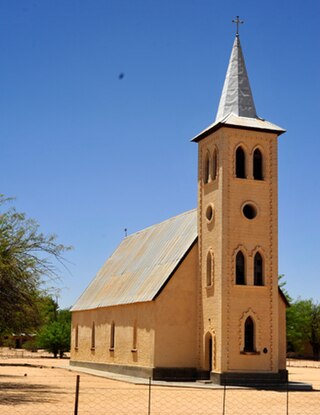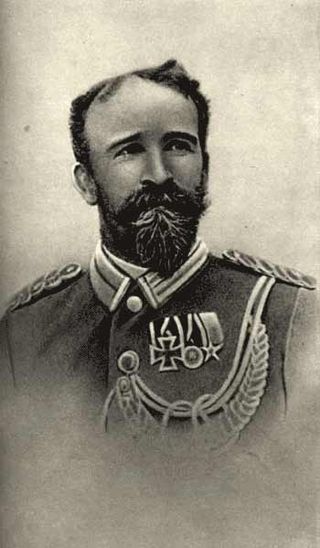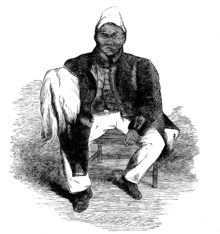
Windhoek is the capital and largest city of Namibia. It is located in central Namibia in the Khomas Highland plateau area,at around 1,700 m (5,600 ft) above sea level,almost exactly at the country's geographical centre. The population of Windhoek,which was 486,169 in 2023,is constantly growing due to a continued migration from other regions in Namibia.

Otjimbingwe is a settlement in the Erongo Region of central Namibia. Otjimbingwe has approximately 8,000 inhabitants and belongs to the Karibib electoral constituency.

Maharero kaTjamuaha was one of the most powerful paramount chiefs of the Herero people in South-West Africa,today's Namibia.

Carl Hugo Hahn (1818–1895) was a Baltic German missionary and linguist who worked in South Africa and South-West Africa for most of his life. Together with Franz Heinrich Kleinschmidt,he set up the first Rhenish mission station to the Herero people in Gross Barmen. Hahn is known for his scientific work on the Herero language.

The Oorlam or Orlam people are a subtribe of the Nama people,largely assimilated after their migration from the Cape Colony to Namaqualand and Damaraland.

Curt Karl Bruno von François was a German geographer,cartographer,Schutztruppe officer and commissioner of the imperial colonial army of the German Empire,particularly in German South West Africa where he was responsible on behalf of Kaiser for the foundation of the city of Windhoek on 18 October 1890 and the harbor of Swakopmund on 4 August 1892.

Jan Jonker Afrikaner was the second oldest son of Jonker Afrikaner and Beetje Boois. He became the sixth and last Captain of the Orlam Afrikaners in South West Africa,succeeding his brother Christian Afrikaner in 1863. He married Mietje Hendrik in Bethanie in December 1842.
Christian Afrikaner was the oldest son of Jonker Afrikaner and Beetje Boois. He became the fifth Captain of the mixed-race Orlam Afrikaners in South-West Africa,after the death of his father in 1861.
Jager Afrikaner was the third Captain of the Orlam people in South West Africa,succeeding his father Klaas Afrikaner at around 1800. Before converting to Christianity through the missionary efforts of Robert Moffat,Afrikaner and his followers were considered notorious bandits. He was one of the founders of Namibia's first systematic settlement in an engineering sense,ǁKhauxaǃnas. After his death in 1823 his son Jonker Afrikaner succeeded him as Captain of the Afrikaner Orlams.
Gross Barmen is a historic settlement and a recreational spa on the Swakop River in central Namibia,north of Windhoek. It is situated on the District Road 1972,25 km south-west of Okahandja in the Otjozondjupa Region. Its close proximity to the capital Windhoek makes it a popular weekend destination for locals.
Hoachanas is a settlement of 3,000 inhabitants in the Hardap Region of southern central Namibia,located 55 kilometres (34 mi) northeast of Kalkrand. It is situated at the junction of the main road C21 from Kalkrand,and C15 from Dordabis to Stampriet and belongs to the Mariental Rural electoral constituency.

Leonardville is a village in eastern Namibia,situated on the Nossob River in the south-western corner of the Omaheke Region. It belongs to the Aminuis electoral constituency.
Amraal Lambert,Nama name:ǂGaiǀnub,was the first Captain of the Kaiǀkhauan,a subtribe of the Orlam,in the eastern area of Namaland,today's Namibia.

Franz Heinrich Kleinschmidt (1812–1864) was a German missionary and linguist who worked in southern Africa,now in the region of Namibia. He founded the missionary station and town of Rehoboth and together with Carl Hugo Hahn set up the first Rhenish mission station to the Herero people in Gross Barmen. Kleinschmidt is known for his scientific work on the Nama language.

Reverend Johann Heinrich Schmelen,born Johann Hinrich Schmelen was a German missionary and linguist who worked in South Africa and South-West Africa. Traveling through the area of today's northern South Africa and central and southern Namibia he founded the mission stations at Bethanie and Steinkopf and discovered the natural harbour at Walvis Bay. Together with his wife Zara he translated parts of the Bible into Khoekhoegowab (Damara/Nama) and published a dictionary.

Tjamuaha was a chief of the Herero people in South-West Africa,today's Namibia,and the father of Maharero. He was a close ally and subordinate of Jonker Afrikaner,Captain of the Oorlam Afrikaners,and stayed with him in Windhoek for most of his chieftaincy. With Tjamuaha's death,hostilities started between the Nama people and the Herero.
The Red Nation is the main subtribe of the Nama people in Namibia and the oldest Nama group speaking Khoekhoegowab,the language often called Damara/Nama.

Manasse ǃNoreseb Gamab was the thirteenth Kaptein of the Khaiǁkhaun,a subtribe of the Nama people in Namibia,between 1880 and 1905. At the start of Imperial Germany's colonisation of South-West Africa,Manasse was one of the most powerful leaders in the area.

The Palgrave Commission (1876–1885) was a series of diplomatic missions undertaken by Special Commissioner William Coates Palgrave (1833–1897) to the territory of South West Africa. Palgrave was commissioned by the Cape Government to meet with the leaders of the nations of Hereroland and Namaland,hear their wishes regarding political sovereignty,and relay the assembled information to the Cape Colony Government.
The Topnaar people (ǂAonin) are a clan of the Nama people in Namibia. Their settlements are all situated on the Kuiseb River in the Erongo Region of central Namibia,the largest one is Utuseb.













